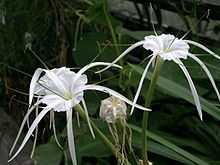Hymenocallis littoralis
| Beach spider lily | |
|---|---|
 | |
| Hymenocallis littoralis | |
| Scientific classification | |
| Kingdom: | Plantae |
| Clade: | Angiosperms |
| Clade: | Monocots |
| Order: | Asparagales |
| Family: | Amaryllidaceae |
| Subfamily: | Amaryllidoideae |
| Genus: | Hymenocallis |
| Species: | H. littoralis |
| Binomial name | |
| Hymenocallis littoralis (Jacq.) Salisb. | |
| Synonyms[1] | |
| |
Hymenocallis littoralis or the beach spider lily is a plant species of the genus Hymenocallis, native to warmer coastal regions of Latin America and widely cultivated and naturalized in many tropical countries.[2]
Description
Hymenocallis littoralis is a bulbous perennial herb. It ranges in height from 60–70 cm (36 inches). The bulb is 7–10 cm (3-4 inches) in diameter. With age, the bulb develops a neck that reaches 4–5 cm in diameter (up to 2 inches). The flowers are large, white, vanilla scented, and sessile. The tepals are adnate (attached to) the staminal cup. Each flower's tube is 14 to 17 cm (5 to 7 inches) long or longer.[3]
Distribution
Hymenocallis littoralis is regarded as native to Mexico, Central America, Colombia, Venezuela, Peru and Brazil. It is considered naturalized in Florida, Cape Verde, Gambia, Guinea-Bissau, Equatorial Guinea, Guinée, Central African Republic, São Tomé & Principe, Zaire (Congo-Kinshasa), Angola, Zambia, the Chagos Islands, Mauritius, Seychelles, Ogasawara ( 小笠原群島 Bonin Islands), India, Sri Lanka, Java, the Philippines, Bismark Archipelago, Fiji, Kiribati, Nauru, Niue, Samoa, Tonga, Marquesas, Society Islands, Micronesia, Hawaii, Ecuador, French Guyana and Suriname.[4]
Horticulture
Hymenocallis littoralis is often grown as an ornamental. It requires sunlight to partial shade for proper growth and blooms from mid-summer to late autumn with white flowers. It may be grown aquatically.[5]
Hymenocallis littoralis is included in the Tasmanian Fire Service's list of low flammability plants, indicating that it is suitable for growing within a building protection zone.[6]
References
- ↑ Tropicos Hymenocallis littoralis
- ↑ "PLANTS Profile for Hymenocallis littoralis (beach spiderlily)", United States Department of Agriculture, 2009 USDA-HL8.
- ↑ "The Amaryllis Family: Genus Hymenocallis", James E. Shields, October 2006, SGardens-Hymenocallis2
- ↑ Kew World Checklist of Selected Plant Families, Hymenocallis littoralis'
- ↑ Garden Bulbs for the South, Scott Ogden, 2007, page 226, ISBN 0-88192-813-5
- ↑ Chladil and Sheridan, Mark and Jennifer. "Fire retardant garden plants for the urban fringe and rural areas". www.fire.tas.gov.au. Tasmanian Fire Research Fund.